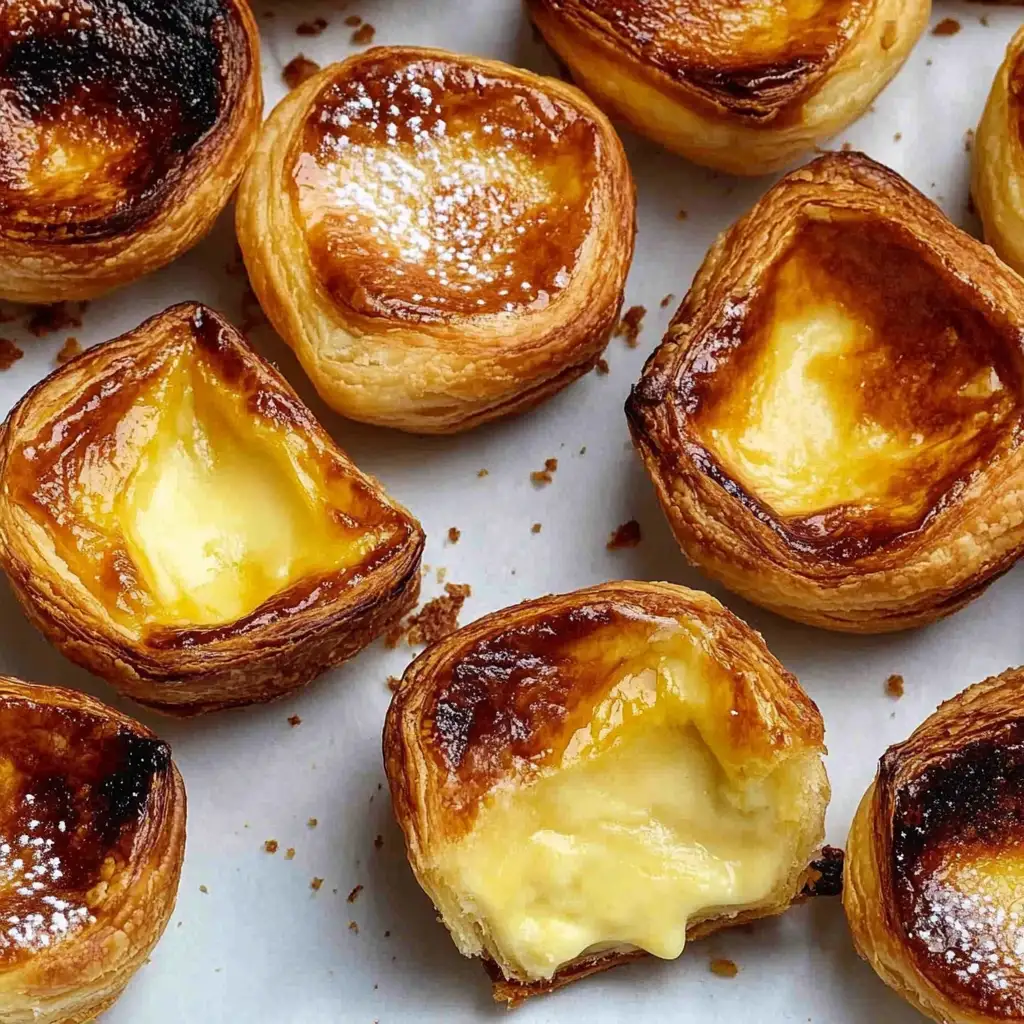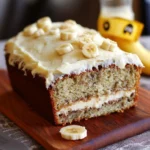Description of this Recipe
Pastel de Nata is a traditional Portuguese custard tart, characterized by its flaky pastry shell and creamy, sweet custard filling. Baked until the pastry is perfectly crisp and the custard is blistered and slightly caramelized, these tarts are a beloved treat enjoyed throughout Portugal and beyond. This recipe provides a detailed guide to recreating this iconic dessert at home.
Why You Will Love This Recipe
You’ll fall in love with this Pastel de Nata recipe because it brings the authentic taste of Portugal right to your kitchen. The combination of the buttery, flaky crust and the rich, smooth custard is simply irresistible. Plus, the satisfaction of achieving those signature caramelized spots on top is truly rewarding. This recipe offers clear, step-by-step instructions, making it achievable for bakers of all levels. Whether you’re looking to impress guests or simply treat yourself, these custard tarts are guaranteed to be a hit.
Ingredients:
- 2 sheets frozen puff pastry, thawed (about 17 ounces total) (such as Pepperidge Farm)
- 1 3/4 cups whole milk
- 2 tablespoons unsalted butter, plus more for greasing
- 1 cinnamon stick
- 1 3-inch strip of lemon peel
- 1 cup granulated sugar
- 2 1/2 tablespoons cornstarch
- 2 tablespoons all-purpose flour
- 4 large egg yolks
Preparation:
Step 1: Preheat oven to 500°F (260°C). This high temperature is crucial for achieving the characteristic blistering on the custard and the crispness of the pastry. Lightly grease a 12-cup muffin pan with butter. Be generous with the butter to prevent the tarts from sticking and to ensure a golden-brown crust.
Step 2: Stack both sheets of puff pastry on top of each other. This will create a thicker, flakier crust. Roll the stacked pastry sheets into a tight log from one end. The tighter the log, the more layers your pastry will have.
Step 3: Cut the log into 12 equal slices, each about 1/2-inch thick. These slices will form the individual tart shells.
Step 4: Dip your fingertips in water. This prevents the pastry from sticking to your fingers. Press the center of each slice down with your fingertips to flatten it into a small disc.
Step 5: Dip your thumbs in water again, and gently stretch and pull the pastry to form a 3-inch wide shallow bowl. Be careful not to tear the pastry. The goal is to create a thin, even layer that will hold the custard filling.
Step 6: Press each pastry bowl into the bottom and up the sides of each muffin cup, extending the edges about 1/4-inch above the top of the pan. This ensures that the pastry will rise properly and form a nice, defined edge. Leave the pastry shells at room temperature while you prepare the custard.
Step 7: Place the milk, butter, cinnamon stick, and lemon peel in a medium saucepan over medium heat. This aromatic infusion is key to the distinctive flavor of Pastel de Nata.
Step 8: While the milk mixture heats, whisk together the sugar, cornstarch, and flour in a medium bowl until thoroughly combined. This dry mixture will help thicken the custard and prevent lumps from forming.
Step 9: Place the egg yolks in a large bowl and whisk until smooth. The egg yolks provide richness and contribute to the creamy texture of the custard.
Step 10: When the milk mixture is just beginning to boil, use a slotted spoon to remove and discard the cinnamon stick and lemon peel. These have imparted their flavor to the milk and are no longer needed.
Step 11: Whisk the flour mixture into the hot milk, whisking constantly, until the mixture thickens but is not boiling, about 1 minute. Continue whisking vigorously to prevent any lumps from forming.
Step 12: Remove the saucepan from the heat. Gradually add the hot milk-flour mixture to the egg yolks, whisking constantly, until well combined. This process is called tempering and prevents the egg yolks from scrambling.
Step 13: Strain the custard mixture through a sieve into a heatproof measuring cup with a spout. This step removes any lumps or imperfections, resulting in a perfectly smooth custard. The spout will make it easier to pour the custard into the pastry shells.
Step 14: Divide the custard evenly among the prepared pastry shells in the muffin cups, filling each cup about 3 tablespoons full. Be careful not to overfill the shells.
Step 15: Bake in the preheated oven until the dough is golden brown and the filling is puffed, about 12 minutes. Keep a close eye on the tarts during this stage to prevent burning.
Step 16: Without removing the pastries from the oven, increase the oven temperature to broil. Broil until the filling is browned in spots, 2 to 3 minutes. This step is crucial for achieving the signature caramelized spots on top of the custard. Watch carefully to prevent burning.
Step 17: Remove the tarts from the oven and let them cool slightly in the muffin pan, about 5 minutes. This allows the custard to set slightly and makes it easier to remove the tarts.
Step 18: Remove the tarts from the pan and cool completely on a wire rack. This prevents the bottoms of the tarts from becoming soggy.
COOKING Rating:
- Difficulty: Medium
- Prep Time: 30 minutes
- Cook Time: 20 minutes
- Total Time: 50 minutes
Serving Suggestions:
- Serve warm or at room temperature.
- Dust with cinnamon or powdered sugar before serving.
- Pair with a strong espresso or a glass of port wine for an authentic Portuguese experience.
- Enjoy as a dessert, snack, or even for breakfast.
Tips:
- Use high-quality puff pastry for the best results.
- Make sure the oven is fully preheated before baking the tarts.
- Watch the tarts carefully while broiling to prevent burning.
- If the pastry is browning too quickly, reduce the oven temperature slightly.
- For a richer flavor, use vanilla extract in the custard.
Nutritional Information:
- (Note: Nutritional information is approximate and can vary based on specific ingredients and portion sizes.)
- Calories: Approximately 250-300 per tart
- Protein: Approximately 5-7 grams per tart
- Sodium: Approximately 100-150mg per tart
Conclusion
Pastel de Nata is more than just a dessert; it’s a cultural icon that embodies the rich culinary heritage of Portugal. With its flaky crust, creamy custard, and caramelized top, this tart is a delightful treat that will transport your taste buds to the sun-kissed streets of Lisbon. This recipe provides a comprehensive guide to making these delectable tarts at home, ensuring that you can enjoy a taste of Portugal whenever you desire. So, gather your ingredients, follow the steps carefully, and prepare to be amazed by the authentic flavors of Pastel de Nata.
Questions and Answers About This Recipe:
Q1: Can I use pre-made custard instead of making it from scratch?
A: While you can use pre-made custard for convenience, the flavor and texture will not be the same as homemade custard. Making the custard from scratch allows you to control the ingredients and achieve the authentic taste of Pastel de Nata. The homemade custard is also specifically designed to bake well in the tarts, resulting in the desired caramelized spots and creamy texture.
Q2: What if I don’t have a muffin pan? Can I use something else?
A: If you don’t have a muffin pan, you can use individual tartlet molds. However, keep in mind that the baking time may vary depending on the size and material of the molds. You can also try using a baking sheet lined with parchment paper, but the tarts may not hold their shape as well. A muffin pan is the preferred option for achieving the traditional shape and texture of Pastel de Nata.
Q3: How can I prevent the pastry from shrinking during baking?
A: To prevent the pastry from shrinking during baking, make sure to chill the dough before shaping it into the muffin cups. Also, avoid overworking the dough, as this can cause it to become tough and shrink. Docking the pastry (pricking it with a fork) can also help prevent shrinkage. Finally, baking the tarts in a preheated oven at a high temperature helps to set the pastry quickly and prevent it from shrinking.
Q4: Can I make these tarts ahead of time?
A: While Pastel de Nata are best enjoyed fresh, you can make them ahead of time and store them at room temperature for up to 2 days. However, the pastry may lose some of its crispness over time. To reheat the tarts, bake them in a preheated oven at 350°F (175°C) for a few minutes until warmed through. You can also freeze the unbaked tarts and bake them directly from frozen, adding a few extra minutes to the baking time.
Q5: What is the secret to getting those signature caramelized spots on top of the custard?
A: The secret to getting those signature caramelized spots on top of the custard is to broil the tarts for a short period of time at the end of the baking process. Make sure to watch the tarts carefully while broiling, as they can burn quickly. The high heat of the broiler caramelizes the sugar in the custard, creating those beautiful and flavorful spots that are characteristic of Pastel de Nata. Using a high oven temperature initially also helps to develop the caramelization.




